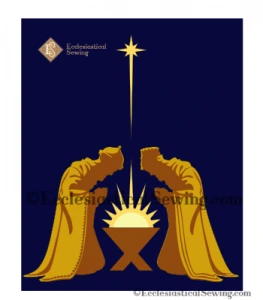Epiphany: A Celebration with Varied Traditions
Epiphany: A Celebration with Varied Traditions
Epiphany: A Celebration with Varied Traditions. If your family is like most families in America, the chances are that gifts are exchanged on either Christmas Eve or Christmas Day. But do you remember the song, “The Twelve Days of Christmas?” Why twelve?
Between December 25 and January 6, there are ten days. Add those days, and you have twelve. In Western churches, we call January 6 “Epiphany.” Certain Orthodox churches that follow the Julian calendar have different dates: January 7 is Christmas, while January 19 is Epiphany. However, the meanings are somewhat the same among all forms of Christianity.
In the West, Epiphany represents the wedding at Cana, the Baptism of Jesus, and the coming of the Wise Men from the East with their gifts. In Catholic countries, the emphasis is placed on the Wise Men, and the holiday is often referred to as “Three Kings Day.”
Epiphany: Traditions Throughout the World
All over Europe, there is a common tradition of a special cake that is made. Most countries call it a “King’s Cake,” and what it has in common is some sort of item hidden inside. There are regional differences: the British make a dense fruit cake, while the Germans and French prefer a spiced form of puff pastry. Other countries enjoy fruit or almond fillings. Regardless of the country, whoever finds the toy or token gets to be “king” for a day and often wears a gold paper crown. In Spain and New Orleans, there’s also a bean hidden in the cake. Getting that means you have to pay for the cake or host the next party.
Other regional traditions are more distinct. In Italy, Spain, and Latin America, children shine their shoes and put them out overnight. It is believed that good children will get nice treats and toys in those shoes, while naughty children will get coal. This coal is a type of rock candy dyed black and is still a seasonal treat. Italians say that a good witch places the gifts, while in Spanish-speaking countries it’s believed that the Three Kings delivered them.
Celebration of Irish Women
Irish women traditionally get the day off, in a tradition called “Women’s Christmas.” The men cook and do the dishes, while the ladies get to have their own party. British, Portuguese, and German families will actually go singing from one door to the next, while certain other countries have parades celebrating the Three Kings, and in Italy people wear costumes. Lastly, in Poland and Germany, there’s a tradition of marking windows and door sills with chalk. The mark is C+M+B, sometimes framed with the year. It stands alternately for the names of the Kings, or for a Latin phrase meaning “bless this house.”
Celebration in Orthodox Countries
Orthodox countries place a different emphasis on Epiphany. Instead of celebrating the Three Kings, most observe Epiphany with a blessing of the water. This tradition is most evident in Greece and Turkey, where the weather is fairly warm in January. Local villagers will process to the nearest body of water, along with a priest and often musicians. There, the priest will throw a crucifix (sometimes more than one) into the water. A bunch of men will jump into the water and try to find the crucifix. Being the person to get the crucifix brings divine favor and protection from evil. Similarly, Russians will cut cross-shaped holes in the ice and jump in, immersing themselves three times each to represent the Trinity. Water in the local churches is blessed as well.
Since Epiphany is a feast day in the Western church, white vestments and paraments are used. Sometimes gold is substituted. There aren’t any specific Epiphany symbols, but there are often representations of the Three Kings elsewhere in churches.
So my question for all of you is this: How are you celebrating Epiphany?
~Soli Deo Gloria~
Be sure to visit our online store front Ecclesiastical Sewing where you may shop for Liturgical Fabrics, altar linen fabrics, church vestment-making patterns, liturgical machine embroidery designs, church vestment trims and notions and so much more. You may also find us on Ecclesiastical Sewing on Facebook, Twitter, and Pinterest. Sign up for our mailing list at the bottom of the page on our online store front and receive a free copy of our Small Linens Booklet as our way of saying thank you for following along.
Sources:
“8 Wonderful International Ways to Celebrate the Epiphany.” The Writings of Cora Evans. Accessed December 29, 2019. https://www.coraevans.com/blog/article/8-wonderful-international-ways-to-celebrate-the-epiphany.
“Christians around the World Celebrate Epiphany | CBC News.” CBC news. CBC/Radio Canada, January 7, 2018. https://www.cbc.ca/news/world/christians-around-the-world-celebrate-epiphany-1.4476356.
“Epiphany Traditions around the World: Musement.” Musement Blog, June 28, 2018. https://blog.musement.com/us/epiphany-traditions-around-the-world/.
JPC-DESIGN, whychristmas?com /. “Epiphany, the Feast of The Three Kings on Whychristmas?Com.” Christmas Customs and Traditions — whychristmas?com. Accessed December 29, 2019. https://www.whychristmas.com/customs/epiphany.shtml.
“Liturgical Colors.” the Revised Common Lectionary. Accessed December 29, 2019. https://lectionary.library.vanderbilt.edu/liturgical-colors.php.
“The History and Traditions of Epiphany from Around the World.” Translingual. Accessed December 28, 2019. https://translingua.com/history-and-traditions-epiphany-around-world/.
The Parable of the Good Samaritan
What’s So Special About Our Epiphany Set?
Vestments From Around the World







 RSS - Posts
RSS - Posts
You must be logged in to post a comment.